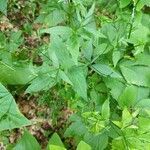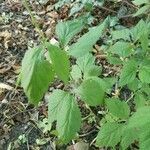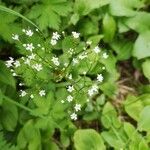Single-stemmed, fibrous-rooted perennial 3–10 dm; lower lvs long-petioled, the upper on short petioles dilated as far as the lfls; lfls lanceolate to rhombic or ovate, 4–15 cm, sharply and irregularly (often doubly) serrate or incised to sometimes lobed; rays 2–7, ascending, 1–5 cm; pedicels several, to 3 cm; fr dark, 5–8 mm; 2n=20. Woods, Que. and N.B. to Man., s. to Ga., Ala., and Tex.; Japan. June, July. (Deringa c.)
A perennial normally grown as an annual. It has a strong taproot. It grows 90 cm high and spreads 50-70 cm wide. The leaves have leaflets along the stalk. The leaves are 10 cm long and the leaflets are sword shaped and have teeth. The flowers are white and in loose heads.



